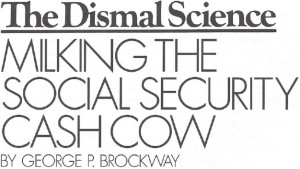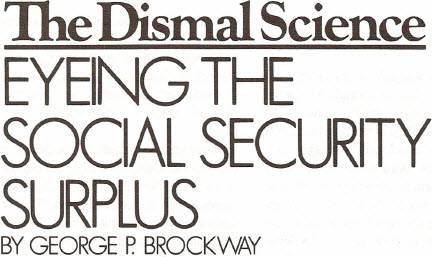By George P. Brockway, originally published January 13, 1997
 THE BEST that can be said for the Advisory Council on Social Security is that after two years of study, its 13 members could not agree on what to do about the allegedly ailing program. They did agree about some of the “facts,” and that agreement is enough to make one relieved they didn’t agree about much else.
THE BEST that can be said for the Advisory Council on Social Security is that after two years of study, its 13 members could not agree on what to do about the allegedly ailing program. They did agree about some of the “facts,” and that agreement is enough to make one relieved they didn’t agree about much else.
Somehow they got into their heads the notion that the program’s surplus, which goes into a “trust fund” invested in long term government bonds, earns only 2.3 per cent interest. They say that rate is “adjusted for inflation,” but I have my doubts. According to the latest figures available, at the end of 1994 the fund contained $415 billion, and in 1995 it earned $31 billion. I make that out to be 7.5 per cent[1]. Taking into account the change in the Consumer Price Index (2.7 per cent), we arrive at a real return of 4.64 per cent[2] more than twice the rate assumed by the Advisory Council.
A point to notice is that there was almost no trust fund until Social Security was “reformed” in 1983. After all, the actuarial problem is not complicated. Even in the BC (before computer) era, the number of people reaching retirement age in any year could be accurately foretold, and reliable estimates could be made of those who would die or become disabled.
In such circumstances it is ridiculous and wasteful to maintain a trust fund. The businesslike thing to do with regular costs is, as the accountants say, to expense them-that is, to pay them as they become due, just as the rent and wages and interest are paid. It is prudent to put aside an amount equal to a few months’ expenses in case another nut imagines he has a contract to shut the government down. Otherwise, in a population as large as ours the risks are as level as can be, and the nation can and should be a self-insurer.
In 1981 David A. Stockman, President Reagan‘s Director of the Office of Management and Budget, worked up some figures purporting to show that the “most devastating bankruptcy in history,” namely that of Social Security, was imminent. A bipartisan National Commission on Social Security Reform was duly appointed. Alan P. Greenspan, then a private citizen, was chairman.
For a year the commission dithered, apparently convinced that Stockman was born for strange sights, things invisible to see. Then, as Senator Daniel Patrick Moynihan later told the story in a newsletter to his constituents, he and Senator Bob Dole put together a semisecret unofficial group to take action. “In brief,” he wrote, “in 12 days in January 1983, a half-dozen people in Washington put in place a revenue stream which is just beginning to flow and which, if we don’t blow it, will put the Federal budget back in the black, payoff the privately held government debt, jump start the savings rate, and guarantee the Social Security Trust Funds for a half century and more.”
The Senator’s circular letter was dated June 10, 1988-less than nine years ago. How did the supposedly magnificent “revenue stream” it describes dry up so quickly? Why must we find a new one now? We hear a lot about the size of the Baby Boomer generation as compared with the size of the succeeding generation. But in 1983 the Boomers were all grown up, and their children were mostly born; so there were no big demographic surprises. It is also said that the Boomers’ life expectancies are longer than those of their parents’ generation. This is certainly true, but just as certainly it should have been obvious to the architects of the 1983 solution. The World Almanac could have told them that life expectancies in the United States have increased every year since at least 1900.
If a blue-ribbon commission somehow got it wrong in 1983, is there any reason to expect that another blue-ribbon commission, perhaps with Mr. Greenspan again as chairman and Messrs. Dole and Moynihan again as members, could get it any better in 1997?
No, there is not. The Social Security Act Amendments of 1983 set up a system of increased taxes and reduced benefits in order to build a trust fund that was expected to take care of things until 2030. Now we are being told by prophets of doom (some of whom were members of the 1983 commission) that we must do something drastic about Social Security entitlements today or the trust fund will run out in 2030, inciting an intergenerational war.
What, I wonder, is all the excitement about? The trust fund was planned to run out in 2030. If the end of the fund in 2030 is expected to signal the end of the Republic, why didn’t the 1983 commission Senator Moynihan was so proud of attend to it, instead of pushing the problem off on another generation? And why should the present generation be saddled with solving a crisis that won’t occur until long after Senator Strom Thurmond has retired? Why shouldn’t the generation of 2030 be expected to solve a problem that will occur, as they say, on its watch?
There are answers, but they’re not what you read about in the papers. The thing is, the Social Security system is what Wall Street calls a cash cow-by far the biggest cash cow, public or private, there’s ever been. Greedy men and women-exemplars of homo economicus—dream about her and can’t keep their hands off her.
Several schemes are being floated simultaneously. Some want to increase Social Security taxes to preserve and increase the trust fund. They want to do that not for any actuarial reason, but because the Social Security surplus is used to reduce the Federal deficit, and there is the possibility (remote yet real) some deficit hawk will get the shocking idea of levying progressive income taxes to control the deficit.
Since Social Security taxes are as regressive as taxes get, an increased Social Security tax is a valuable trade-off for the benefit of the rich and famous. It’s even better for them than the Forbes flat tax, because the tax starts with the first dollar anyone earns (that sticks it to the lower classes!) and ends at $65,400 instead of continuing on to tax every last megabuck reaped. In addition, it is a tax only on those who are employed and those who employ them. If you are an economic specialist and restrict your activity to clipping coupons and cashing dividend checks, you don’t pay any Social Security tax at all.
As it happens, Senator Moynihan understood the ploy in 1990 and tried to forestall it by reducing Social Security taxes and returning the system to a pay-as-you-go basis. When he couldn’t persuade his fellow Democrats to go along, he asked why we needed the Democratic Party. It was, and too often still is, a good question.
Another greedy scheme yields an additional motive for wanting the Social Security surplus to be ever larger. Brokers and investment bankers have long had their eye on the trust fund. For them it presents a charming opportunity. Think of it! Imagine your rich and doting uncle[3] turning over to you a fund of half a trillion dollars, now growing at the rate of close to $50 billion a year, and instructing you to churn the market and make it grow faster. Wouldn’t that be fun?
It would, in fact, be unadulterated fun. You wouldn’t have to weary yourself persuading tens of millions of timorous senior and pre-senior citizens to entrust their savings to you; your uncle would handle that. Nor would you have to maintain tens of millions of separate accounts and draw and mail tens of millions of checks every month, together with resolutely upbeat letters explaining why benefits are less than expected. Your uncle would handle those chores, too. A very handy and efficient fellow, that uncle, regardless of what you may hear on the radio.
MOST OF THE “reformers” put great stress on the questionable assertion that an individual citizen knows better what to do with his or her money than some faceless and indifferent bureaucrat in Washington. This tired old wheeze goes back at least to Adam Smith, whose faceless and indifferent bogeys were, Smith-quoters may be astonished to learn, not government employees, but members of the boards of directors of private corporations, some of which were remarkably similar to today’s mutual funds.
Let us try to foresee what would happen if some privatization scheme-say, investing 25 per cent of the trust fund in the stock market-should be adopted by Congress and signed by the President. Since, as we noted in “Caught in a Boom Market” (NL, September 9-23, 1996), the number of available shares is limited, the influx of something more than $125 billion would send prices shooting up. But it would have taken a while to get the “reform” bill through; consequently, much-if not all–of the rise would have been anticipated by smart money pulled out of other investments. The trust fund would not participate in the initial boom. Also, the source of the cash needed to move into the market would be a problem. The trust fund would have to redeem some of the government bonds it is holding, the Treasury would have to sell other bonds to get money to pay these off. In other words, the deficit would be increased by the amount invested in Wall Street.
Where would the money to buy the new bonds come from? All the smart money would already be in the stock market’ but perhaps there would be some timid money eager to shift from stocks to bonds, especially if the new bonds were priced low enough to yield an attractively high rate of interest. The high interest would send stocks down as more money shifted from stocks to bonds; then some would shift the other way, just as money sloshes from technology stocks one day to nursing homes the next. Where would the turmoil end? It would not end. As Ring Lardner might have said, that would be part of its charm.
Both the stock market and the bond market are always churning, because traders are constantly evaluating and reevaluating possible investments, trying to determine their comparative future earnings, capital gains and risk. When the market is volatile, the vital question is what the various stocks and bonds are going to sell for tomorrow. In the end, this all is guesswork, even when mainframe computers spew out charts of many colors: What’s to come remains unsure.
If the stock market is now “outperforming” the bond market, it is because the stock market is considered riskier, and the claimed difference in performance is a measure of the perceived risk. The very term “social security” suggests that the program is correct in its present stance of being risk-averse.
Some claim that investing Social Security funds in the stock market would send prices even higher, and that high stock prices make it easier for new companies to be launched and old companies to be expanded. Other things being equal, as economists say, this claim may be sound enough, but there is another side to it. When the market is really soaring, it becomes much simpler to make money by speculating in stocks and bonds than by producing commodities for people to use and enjoy. Things apparently are not equal at the present time, for leading American companies seem to have more cash on hand than they know what to do with. Why else would IBM and so many others be buying back their own stock instead of investing in new or expanding enterprises?
All that would be accomplished by putting Social Security funds at risk in the stock market, it can safely be said, would be a steady upward redistribution of income and wealth. The rich would in general become richer, and the poor poorer. Try as they may, some people seem never to be near a chair when the music stops.
Stockholders and bondholders (both new and old) would, as a group, be likely to prosper about as fast as, but no faster than, the Gross Domestic Product. The only way they might have the illusion of prospering more grandly would be if inflation accelerated. Brokers and investment bankers would be the big winners in fact, taking them as a group, the only winners. The cash cow would be lavish with commissions and fees and interest on margin accounts.
The costs of moving the Social Security trust fund into the market-particularly the increased deficit and the interest bill on the new bonds-would be borne by the government. There would be a furious struggle to decide whether to increase the debt or to downsize the budget. No matter how it was resolved, those at the bottom of the income scale would be pushed lower. Almost all bonds are necessarily bought by the rich; the interest they receive is, in our present tax system, disproportionately paid by the lower middle class-the same people who typically suffer when the budget is shrunk.
It all comes down to this: Individuals can, and many do, make out like bandits on Wall Street, but society as a whole cannot be more comfortable or more secure without producing more goods and services. Whatever it is that Wall Street produces, it is good neither to feed you if you’re hungry, nor to clothe and shelter you if you’re cold, nor to heal you if you’re sick.
The New Leader
[1] Do the math, the author is correct
[2] The author appears to have subtracted 2.7% from 7.5%… Ed. I don’t follow why that’s the right calculation



